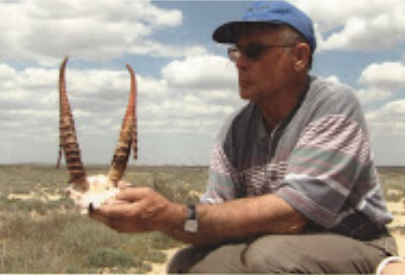Saiga Hero - Yuri Grachev

Dr Yuri A. Grachev is Senior Fellow at the Institute of Zoology of the Ministry of Education and Science in Kazakhstan, and Candidate of Biological Sciences.
The editor of Saiga News interviews Yuri Grachev
Yuri's interests include the ecology, conservation and use of mammals, mainly ungulates and carnivores. He has worked in this research area since 1962, and is author of many articles about saigas, including the monograph "Saiga (origin, systematics, ecology, conservation, use)", published in Moscow in 1998.
He is a world expert on saiga ecology and behaviour, and someone who saiga researchers globally view with deep respect and admiration.
Editor: When did you first become interested in saiga?
rom the first time. I got a bird's-eye view of saigas from an AN-2 plane during an aerial survey in 1963. The saiga population was quite big at that time, so you could see hundreds or even thousands of running animals. The view itself was really impressive. Later on, I participated in many saiga aerial surveys, though my scientific research was dedicated to mountain ungulates and large carnivores. However, I really liked being involved, not only with aerial surveys, but also with field research on saiga ecology. This extraordinary animal fascinated me.
Editor: When did you start to study saigas and work towards their conservation?
he study of saiga was a priority in our mammal laboratory. The laboratory was led by an outstanding zoologist, Arkady Sludsky, (until 1978) who ran a systematic research programme on saiga antelopes in Kazakhstan. Vitaly A. Fadeev had also researched the ecology of saigas between 1966 and 1980. The results of their work were published in a book called 'Saiga in Kazakhstan' (Fadeev & Sludsky 1982). After the untimely death of V. Fadeev in 1987, I became responsible for the laboratory's saiga research and have been doing so ever since.
Editor: What does your average day look like?
When I work in the field, most of the time is occupied by observing saigas (using binoculars or telescopes) and driving survey routes. During calving the activities include tagging calves, weighing, sexing, etc. Meanwhile, work in the city requires processing the collected materials, writing reports and articles, attending meetings, conferences etc.
Editor: Can you tell us an interesting story about saigas?
Saigas have many interesting habits and sometimes they are totally inexplicable. For example, the way saigas overcome water obstacles. Once our camp was set up on Turgai riverbank in spring (May). There were lots of saigas and they had been crossing the river back and forth for no apparent reason. It seemed that they 'liked swimming'. In addition, one of the saiga herds faced quite a wide lake across their path right before freeze-up in November. The saigas crossed it without stopping, although there was a way round not far from the lake.
Editor: What are the major problems in your work?
Primarily it is a lack of funding for research. Therefore there is no opportunity for young professionals to become involved.
Editor: How can these obstacles be overcome?
The only way is to increase public funding of science in general and saiga research in particular.
Editor: What is the best part of your work?
I enjoy field expeditions, the opportunities to observe animals, and interactions with friends and colleagues from different countries involved in the study and conservation of saiga.
Editor: What are the prospects for saiga conservation, and what should be done first in order to help this species survive?
The number of saigas is getting larger in Kazakhstan these days after the dramatic fall in the 1990s. It gives us hope for the future. However, poaching continues and there are also cases of mass deaths as a result of disease. Fortunately, some studies of saiga diseases were initiated in recent years. The situation with poaching is much more problematic. It requires a collective efforts of all law enforcement agencies and long-term work with local people. But it seems that the real threat of losing saiga is over for now.
Editor: You have been working on study and conservation of rare species over the last few decades. What has changed over the years, and what are the current trends in this area?
Generally speaking, conservation of rare species in Kazakhstan has improved due to the expansion of existing protected areas and establishment of some new ones. These are national parks and nature reserves. Additionally, a few projects aimed at studying and protecting rare ungulate species (argali, gazelles, onagers, Bukhara deer and saiga) have been carried out since 2005
